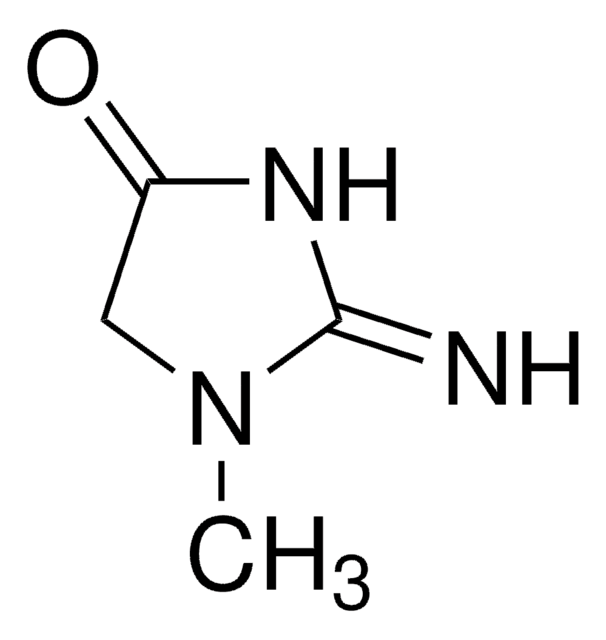MAK079
Creatine Assay Kit
sufficient for 100 colorimetric or fluorometric tests
Sign Into View Organizational & Contract Pricing
All Photos(2)
About This Item
UNSPSC Code:
12161503
NACRES:
NA.84
Recommended Products
usage
sufficient for 100 colorimetric or fluorometric tests
application(s)
cosmetics
food and beverages
detection method
colorimetric
fluorometric
relevant disease(s)
neurological disorders; genitourinary disorders
storage temp.
−20°C
General description
Creatine is a nitrogenous compound that acts as a high-energy reservoir for the rapid regeneration of ATP. Approximately 95% of creatine is found in skeletal muscle, primarily as phosphocreatine. Creatine can be acquired through dietary consumption or formed from L-arginine, glycine, and L-methionine in a multi-step reaction that occurs in the kidneys and liver. Creatine is then transported to muscle tissue. Creatine supplementation is used for the enhancement of sports performance, primarily by increasing muscle mass. Creatine is also being investigated as a treatment of neuromuscular diseases, where it may aid in neuroprotection and by improving the cellular bioenergetic state.
Application
Creatine Assay Kit has been used to analyze the creatine content in samples.
Suitability
Suitable for the measurement of creatine in biological fluids including serum, urine, CSF etc.
Principle
In this assay, Creatine concentration is determined by a coupled enzyme reaction, which results in a colorimetric (570 nm)/fluorometric (λex = 535em/λ = 587 nm) product, proportional to the creatine present.
replaced by
Product No.
Description
Pricing
Hazard Statements
Precautionary Statements
Hazard Classifications
Aquatic Chronic 3
Storage Class Code
10 - Combustible liquids
WGK
WGK 3
Regulatory Information
常规特殊物品
Choose from one of the most recent versions:
Certificates of Analysis (COA)
Lot/Batch Number
Don't see the Right Version?
If you require a particular version, you can look up a specific certificate by the Lot or Batch number.
Already Own This Product?
Find documentation for the products that you have recently purchased in the Document Library.
Stanniocalcin-1 protects a mouse model from renal ischemia-reperfusion injury by affecting ROS-mediated multiple signaling pathways.
Liu D, et al.
International Journal of Molecular Sciences, 17(7), 1051-1051 (2016)
Adam Zajac et al.
Nutrients, 12(10) (2020-10-02)
The aim of the study was to evaluate the effects of 16 weeks of a low dose of magnesium creatine chelate supplementation on repeated sprint ability test (RAST) results in elite soccer players. Twenty well-trained soccer players participated in the
Sandra D Chanez-Paredes et al.
Methods in molecular biology (Clifton, N.J.), 2367, 249-271 (2021-04-09)
The intestinal barrier is an essential component of innate host defense. The single layer of epithelial cells that line the intestine must balance barrier function with both active, transcellular and diffusive, paracellular transport. Tight junctions, which link adjacent cells, form
Paul Ikgan Sia et al.
Investigative ophthalmology & visual science, 60(13), 4360-4377 (2019-10-22)
To investigate the neuroprotective properties of creatine in the retina using in vitro and in vivo models of injury. Two different rat retinal culture systems (one containing retinal ganglion cells [RGC] and one not) were subjected to either metabolic stress
Aslaug Drotningsvik et al.
The British journal of nutrition, 120(7), 740-750 (2018-08-30)
Obesity increases the risk for developing kidney disease, and protection of kidneys through changes in diet should be investigated. Fish intake has been associated with reduced risk of developing kidney disease; therefore, we wanted to investigate whether cod protein intake
Our team of scientists has experience in all areas of research including Life Science, Material Science, Chemical Synthesis, Chromatography, Analytical and many others.
Contact Technical Service
